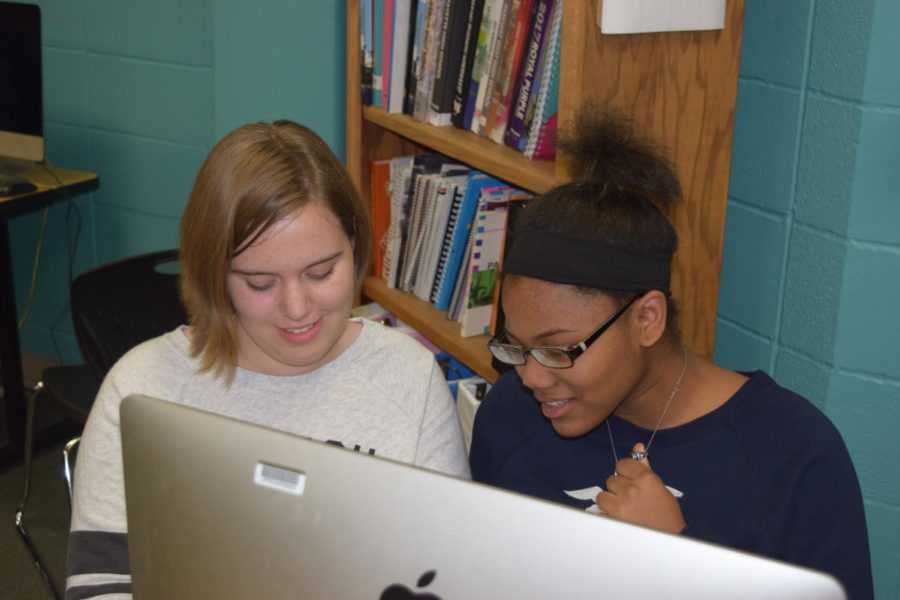Bus rides, bigotry and alumna Gabrielle Thompson’s high school experience
December 7, 2018
Providing each other feedback, alumni Sydney Kinzy and Gabrielle Thompson revise fiction stories they wrote. Both were members of the literary magazine production club, Reflections, which met once a week on Mondays. “Any clubs that took place before school or on Fridays, I had no possible chance of participating in them due to either the city buses showing up too late to school or there being no transportation available at all,” Thompson said.
The clock strikes 4 a.m., but alumna Gabrielle Thompson is already wide awake. A pitch black skyline engulfs St. Louis City amidst a bitter, cold morning that native Missourians know all too well.
“I was definitely dependent on coffee for all four years of high school,” Thompson said.
Now a freshman at St. Louis University, the Class of 2018 graduate recalls an hour-plus long bus ride that culminated in a social life constrained by inadequate transportation services and open hostility from some of her white West County peers.
While closer proximity to campus allows many county students to ease into a consistent daily routine, rides to and from school proved to be anything but certain for Thompson.
“The bus ride was usually about an hour long, sometimes longer if they made us combine buses. The time I got to school depended on a lot of things, such as how much traffic was on Highway 40 [and] whether or not the bus broke down, which it did a lot,” Thompson said. “At the end of the day, if I had the time, I’d run to my locker and get rid of the books I didn’t need to save my back some pain. If I didn’t have time, I’d just suck it up and run to my bus because the bus drivers were leaving at 2:40 p.m. whether you were on the bus or not.”
Teachers, counselors and college admissions departments alike continue to preach the benefits of getting involved in athletics and extracurricular activities. All the while, Thompson’s aspirations of bridging social gaps through various clubs, sports teams and school events were effectively dead on arrival. Outside of the literary magazine production club, Reflections, and the African-American Student Acceleration Program (ASAP), she was more or less shut out of many opportunities offered at West due to reliance on either her working mother or school bussing for transportation.
“[Living in the city] impacted my social life in that I didn’t have one. Not having reliable transportation out to the county definitely affected my ability to participate. I couldn’t participate in any of the clubs that had meetings before school because my bus would never make it to school early enough,” Thompson said. “I couldn’t participate in any of the clubs or events that happened on Fridays because the after school city buses only ran from Monday to Thursday. Going to any basketball or football games were out of the question unless I could spend the night with one of my friends who lived in the county. A lot of my friends actually lived out in the county, but I barely got the chance to see them outside of school.”
A 2017 study conducted by graduate students and professors at the University of California, Riverside and San José State University presents “research that brings to light racism’s permanence and significance in the lives of students of color.” Even in the absence of legalized segregation, Thompson cites personal experiences with bigotry to corroborate this notion.
“I’ve had students who aren’t black say the n-word around me and justify it by saying, ‘my black friends say it’s okay if I say it.’ I’ve seen students completely disregard and invalidate the Black Lives Matter movement,” Thompson said. “I always felt uncomfortable discussing political and racial issues in any form at school. I feel like if I had mentioned the Black Lives Matter movement in any capacity, I would have been immediately shut down by my fellow students. I distinctly remember in my senior year, a few juniors making fun of the protesters in the city after the acquittal of Jason Stockley, and I just remember feeling so disgusted.”
Thompson also points towards misinformed stereotypes as a reason for the city-county disconnect.
“I feel like the most challenging part of being a city student in the middle of West County was just how different the county students were from the city students. So many students thought that the living in the city meant I had to dodge bullets 24/7 or that people were committing crimes all the time,” Thompson said. “I do admit that some parts of the city are dangerous, but every city has crime. St. Louis isn’t special in that regard. I’ve out of nowhere had multiple people ask me, ‘do you hear gunshots every night?’”
As West continues to explore methods for promoting diversity and tolerance, Thompson has one message for her former administrators and teachers: whatever the school does must be genuine and not a watered-down curriculum.
“I’m a little hesitant to say anything seeing as the past few times West has tried to be inclusive people turned it into one big joke, but I would say having more guest speakers come in would be a great learning experience,” Thompson said. “I remember one of the remaining members of the Little Rock Nine, [Terrence Roberts], came to speak at our school, and people were actually taking his message to heart. I feel like it’s hard to disregard someone’s experience if they’re speaking directly to you versus just reading about someone’s experience or watching a video.”

